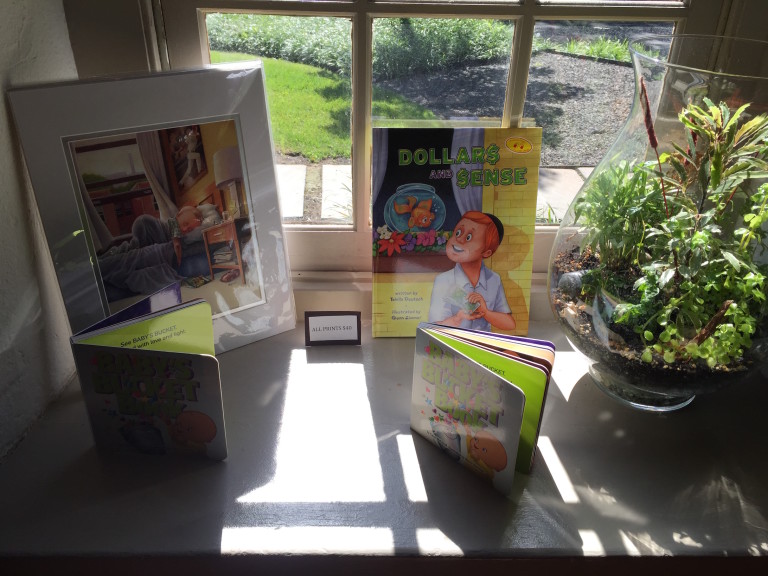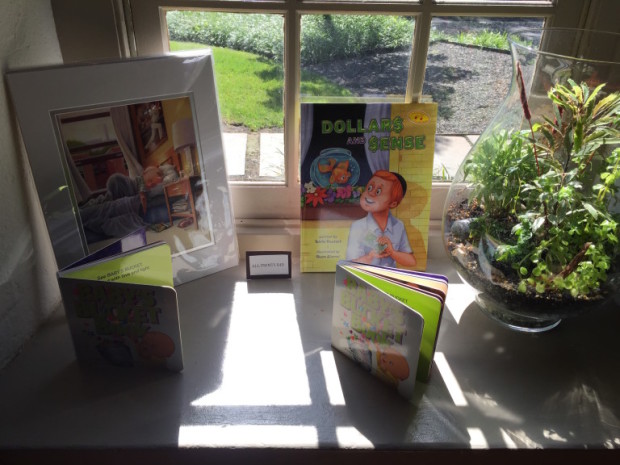An Interview with Illustrator Glenn Zimmer, from the Scatter Joy Center for the Arts Blog
An interview with children’s illustrator Glenn Zimmer: ‘I consider myself a child at heart’
This April, we have award-winning children’s illustrator Glenn Zimmer with us, teaching an Introduction to Colored Pencil Drawing workshop.
The versatile Montgomeryville, Pa.-based artist is known for his humorous character designs, as well as his collaborations with Compass Media, purveyors of ESL readers, and children’s literature producers Hachai Publishing. Zimmer also illustrated “Bucket Filling from A to Z” and “Baby’s Bucket Book” — both winners of multiple national and international awards — written by the ever-popular Bucket Lady Carol McCloud (with Caryn Butzke as co-author on “Bucket Filling”). With more than 30 years of publishing experience, his extensive career background includes graphic design, digital production techniques, art direction, catalog development, and corporate management. His illustrations have also been featured across a wide range of media from Major League Baseball publications to The Wall Street Journal.
Here, Zimmer, who teaches professional development in the illustrations department at Moore College of Art & Design, talks about changes in the field, his journey from commercial art to children’s publishing, and his appreciation for a little bit of escapism.
How has the field of art illustration evolved since you graduated from the Art Institute of Philadelphia?
The major impact has been the development of the Internet, as well as creative digital tools and software. Another major impact has been the technological development of the printing process and color reproduction.
You occasionally assist juniors and seniors with their portfolios and advise juniors in fulfilling their internship requirements. What are some of the challenges you see students facing upon graduation?
They will need to find the most profitable markets for their work. The Internet allows an illustrator to compete for work on a global basis. But the flip side is that the global market also allows for much greater competition. They also need to establish themselves as a viable business, knowing their value as creatives while keeping their pricing competitive.
How else has technology changed the way illustrators work today?
Obviously, the marketing capability of the Internet — the ability to send your finished art digitally anywhere in the world within minutes — has opened markets for an illustrator’s work to be delivered almost in real time. Also, technology has created capabilities such as scanning original art, image manipulation, color correction and communication with clients and vendors virtually anywhere in the world.
Having been raised on the work of caricaturists and comic book artists like Mort Drucker, John Buscema and Jack Kirby, you always wanted to create and illustrate comics. But your first job was as a layout artist for Gimbels Department Store. What did you learn at Gimbels that’s guided you throughout your career?
Creating pages for print furthered my understanding of spatial relationships. I had an instructor in art school who stated, “The first mark you put on a page is important and the next one takes it one step further.” I never fully understood the statement until I had been designing for the printed page for many years. He was referring to relationships between graphic elements in a two-dimensional surface and how they relate to each other and the negative space.
My responsibilities as a layout artist also required me to work quickly and efficiently. That provided me with terrific training in a deadline-oriented industry.
 You spent considerable time in the commercial art world (and still do) working as an art director and graphic designer. Tell us a little about your creative process in those positions.
You spent considerable time in the commercial art world (and still do) working as an art director and graphic designer. Tell us a little about your creative process in those positions.
Zimmer exhibited some of his children’s illustrations at the Scatter Joy Center for the Arts last year.
As a graphic designer, I was able to conceptualize an idea and take it to the next level. I learned to work with art directors, illustrators and photographers. I found the position of art director less fulfilling creatively as this position, in a corporate environment, required more supervisory, purchasing, production and training responsibilities and significantly less time for creative activity.
How did those experiences prepare you for the world of children’s illustration?
Because of my background, I believe that I have the ability to take a project, such as a children’s book, from concept to completion. My experience has also enabled me to collaborate with other illustrators and publishers using my design and production experience to bring their projects to print.
You began illustrating children’s books in 2010. Was it challenging to make the transition from commercial art?
Creatively, no. It has been exciting as I am able to visually present a story to a child and hopefully influence them in a positive way.
When your daughter was in elementary school, you loved seeing the kids’ artwork when you attended events at her school, and she’s the one who inspired you to begin doing children’s illustrations. Is it valuable to have the perspective of a parent who’s been immersed in a child’s world to be in the field?
Absolutely. My daughter is very creative in her own right and has been a constant inspiration to me. However, I consider myself somewhat of a child at heart. I also possess an incredible long-term memory. I can remember feelings, colors, smells and personal interactions that I had as a child. My short-term memory is not quite as good. Just ask my wife.
What have you learned from children that serves you in your work?
I observe the children’s feelings in their interactions with other children and adults, and in this world that we live in, their sensitivity to their environment.
When you’re not limited by the constraints of a particular assignment, where else do you find inspiration?
Good question! I would say concepts and ideas come mostly from my own imagination and experiences. Technically speaking, I love to browse bookstores and view other illustrators’ and designers’ work for art style and visual pacing of a story.
Do you have a favorite among the children’s books you’ve illustrated?
My favorite has been “Bucket Filling From A to Z” as I had the incredible experience and privilege to work directly with the people at BucketFillers, Inc. My association with author and founder Carol McCloud has been especially fulfilling, as she is extraordinarily talented, kind and inspirational.
You also illustrate and write your own children’s books. Will we see any of those soon?
I have been shopping around some manuscripts. However, I have just finished illustrating “There’s A Reason Why” for Hachai Publishing, which should be published this summer or early fall.
Zimmer illustrated “Dollars and Sense” for Hachai Publishing and “Baby’s Bucket Book” for Bucket Fillers, Inc.
 Are there any misperceptions about being a children’s illustrator that you’d like to clarify?
Are there any misperceptions about being a children’s illustrator that you’d like to clarify?
Not really. Everyone that I have met in the children’s publishing world has been kind, professional and supportive. At one conference, attendees described themselves as “looking at the world through rose-colored glasses.” Although you could probably say it is a form of escapism, I liked it.
What is the most rewarding thing about your work?
My greatest thrill, without a doubt, is seeing children enjoy my art. A few years ago, one of the educational publishers that I have been associated with conducted a survey among educational institutions that have purchased their books. It was my honor to be chosen by the children as their favorite illustrator.
You’ll be teaching a class in colored pencil drawing, your favorite medium, for us. What do you most appreciate about that application process?
It is the control that you have applying the color. The color is built up slowly in a layering process so that you are considering your application technique with every stroke.
Glenn Zimmer will teach a workshop on the basics of layering color using colored pencils from 9:30 a.m. to noon April 9 at the Scatter Joy Center for the Arts in Horsham. Registration and more information can be found here.
Reprinted from the blog of the Scatter Joy Center for the Arts. Copyright © 2016 Scatter Joy Center for the Arts. All rights reserved.












0 Comments